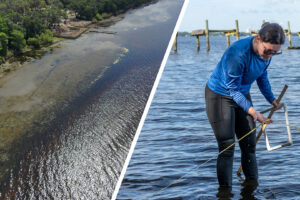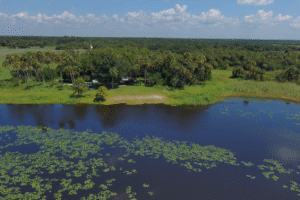Celebrating 10 years of collaboration in the Upper St. Johns River Basin

Josh Papacek, an environmental scientist with St. Johns River Water Management District, discusses harmful algal blooms at the Upper St. Johns River Basin Research and Management Consortium, held at the Florida Solar Energy Center on Dec. 4, 2024.
What started as a conversation between two colleagues back in 2014 has blossomed into a network of environmental professionals and passionate individuals. The Upper St. Johns River Basin Research and Management Consortium held its 10th annual gathering, marking a decade of collaboration and a shared commitment to safeguarding one of Florida’s most vital ecosystems.
Spanning Indian River, Brevard, and parts of Okeechobee, Osceola, Orange, Seminole and Volusia counties, the Upper St. Johns River Basin plays a significant role in the region’s flood protection and habitat preservation. It is home to diverse wildlife, including several threatened species, and provides habitat for migratory birds, fish and native plants. The region’s wetlands help filter pollutants and improve water quality. Economically, the area supports local industries such as agriculture and tourism, with thousands of visitors coming annually to experience the area’s natural beauty and recreational opportunities. However, this delicate ecosystem is threatened by challenges such as nutrient pollution (when too many nutrients, like fertilizer and waste, get into the water) and invasive plants and animals.

District environmental scientists Anabelle Baggs (left) and Kim Ponzio (right) co-organized the consortium.
The idea for the event was born from a simple, but important, realization shared by environmental scientists Kim Ponzio and Dean Dobberfuhl with the District: the challenges facing the Upper St. Johns River Basin were too complex for any single organization or agency to tackle alone. Together, they envisioned a collaborative space where diverse stakeholders could exchange knowledge and work together on research to better manage the ecosystems of the region. Ponzio embraced the idea, organizing the first event in 2015. “We believed it would be valuable for everyone working in the region to understand what other researchers and organizations were doing, so we could leverage our resources and share know-how on applying science-based management in the basin,” she explains.
What began in 2015 with just 27 attendees has expanded to nearly 90 participants in recent years.
Ponzio has been organizing the consortium for the past decade, while Annabelle Baggs, also an environmental scientist, has co-organized the event for the past two years. “From coffee to content, we plan it all,” Baggs shares.
“We faced a few scheduling challenges due to Hurricane Milton, but we managed to reschedule and get the consortium back on track.”
The 10th anniversary gathering featured 20 presentations on a wide range of topics—from wetland mapping and harmful algal blooms to invasive plant management and waterfowl banding and surveys. Respected speakers from organizations including the District, Florida Fish and Wildlife Conservation Commission (FWC), Florida Atlantic University, University of Florida, United States Geological Survey, South Florida Water Management District and Breedlove, Dennis & Associates provided valuable insights into ongoing research and management efforts.

Attendees of the consortium explore a collection of retro posters showcasing work in the Upper St. Johns River Basin over the past three decades.
Between sessions, attendees had the chance to step back in time, exploring a collection of retro posters from the past three decades. These posters represent a rich history of dedication and impactful projects of those working to protect the region. The oldest piece, dating back to 1994, highlights early efforts in wetland restoration through seed banks—a reminder of how much has been accomplished over the years.
“The connections, teamwork and shared research we’ve built over the years have truly enhanced our ability to manage and protect this important ecosystem,” says Ponzio.

Participants engage in discussions and network during a break.
The consortium has facilitated research and knowledge exchange while strengthening partnerships between public agencies and universities. One notable success involves the endangered snail kite, a bird species that historically nested in the region. Through monitoring funded initially by the District and later joined by the South Florida Water Management District and the U.S. Army Corps of Engineers, the University of Florida has been able to collaboratively monitor long-term population trends and identify critical habitat components. This research has not only helped to protect the bird’s habitat but has also provided important insights into the ecological balance of the region.
Another accomplishment came from a partnership between the District and FWC. Sparked by discussions at a previous consortium, the two agencies began meeting regularly to address shared concerns. One pressing issue was the increasing presence of tilapia and armored catfish in the lakes and headwaters of the St. Johns River. These invasive species pose a threat to native fish populations and water quality. In response, the two agencies launched a project to remove the invasive fish. This removal process benefits water quality by eliminating the nutrients stored in the fish and supports a healthier lake ecosystem.
To learn more about the District’s commitment to the protection and conservation of the Upper St. Johns River Basin, please visit www.sjrwmd.com/waterways/st-johns-river/upper.





